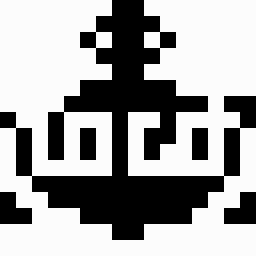 Anti-maths
syndrome
under attack
Anti-maths
syndrome
under attack
In the very first OZNAKI Turtle
the robot vehicle was the chassis of a toy tank.
A hole drilled centre was for inserting a pen for track drawing.
Note also the small siren horn.
During 1976 the ZONKY robot was refined, microprocessor sofware was developed,
so that the very first microcomputer LOGO
was implemented running
on a Poly-88 micomputer.
|

ZONKY the first Turtle Robot constructed outside US/UK,
could go F(orward), B(ack),
R(ight), L(eft),
while H(onking) and A(light),
and sing a simple tune.
Click for the engineering details of the ZONKY robot
Click
to
read proclamation of the objectives of the Oznaki project,
which were published late 1975 in the La Trobe University Record.
|
Cuisenaire Colours

were adopted for the OZNAKI Tiny Tot calculator:
THE PLUSMINUS


PROTOTYPE
Electronic
1975
PROGRAM VERSION
The PlusMinis modelled operation of addition (+) and subtraction (-) by adding/subtracting one
from the number of lights on.
This toddler's calculator, with large + and - keys,
featured row of 9 lights, each above a number 1 ..9.
illuminated in
Cuisenaire colours.
The user is aged 20 months.
This electronic calculator was replaced
by graphics
program
PLUSMINUS
in 1977,
where either a large two key pad was used,
or speech input via a microphone.
Computer was the Poly-88, with same "s-100" bus
as the Altair. Speech Input was via
a s-100 bus speech I/O board.
See pix speech I/O
|

|
These web pages offers brief glimpses of the OZNAKI project. Three key papers on OZNAKI are downloadable as PDFs

|
Harvey A. Cohen, OZNAKI and Beyond, [U.S.] National Educational Computing Conference
H.A. Cohen, OZNAKI and BEYOND, in D. Harris (Editor),
Proceedings of National Education Computing Conference, NECC '79 The University of Iowa, Iowa, June 1979, pp 170-178.
|

| Harvey A. Cohen and David G. Green, Evaluation of the Cognitive Goals of OZNAKI: Enhancement of Spatial Projective Abilities, in A.M. Wildberger and R. G. Montanelli, (Editors), "ACM Topics in Instructional Computing"' ACM Special Interest Group Computers in Education, SIGCUE, New York, 1978, pp 69-90
|

| H.A. Cohen, Expanding the Child's Concept of Number, Space and Operation, in M. Poole (Editor), From Creativity to Curriculum, Allen and Unwin, Sydney, 1980, pp 147-162.
|
|
|
|
 Click on small turtle to download the November 1975 newspaper story
about the prototype version of ZONKY,
based on model tank chassis. For the protype,
a control program had been implemented in the early programming language ALGOL,
and the robot was directed by serial ASCII commands coming
from a the La Trobe University DEC-10 Computer.
The robot shared the same (two wire) serial line
with a terminal of the era, shown in the attached pix.
Click on small turtle to download the November 1975 newspaper story
about the prototype version of ZONKY,
based on model tank chassis. For the protype,
a control program had been implemented in the early programming language ALGOL,
and the robot was directed by serial ASCII commands coming
from a the La Trobe University DEC-10 Computer.
The robot shared the same (two wire) serial line
with a terminal of the era, shown in the attached pix.
Key points of the story are:
Zonky adds up to fun
Michael Wilkinson
To be honest , Zonky is a show-off of the worst kind. He does whatever you ask, and does it perfectly -
but always with some attention-seeking flourish.
. . . . Zonky looks like a super-duper toy tank. And he is, except he is the very latest in teaching aids.
. . . . certainly not the sort of thing you expect in a getting to know maths lesson. After all,
for years, learning maths seemed to to consist largely of excessive repetitions of
multiplication tables, then, once these were grasped,
abstract brain teasers about the values of "x" and "y".
The education philosophy expounded had been heavily influenced by
six months spent by Dr Cohen in 1975 within the LOGO
Group Project, of the MIT Artificial Intelligence Laboratory.
There he worked with Seymour Papert, author of the paper
"Teaching Children to be Mathematicians
versus Teaching them about Mathematics,"
International Journal of Mathematical Education in Science and Technology
Volume 3, Issue 3, 1972, pp249-262.
Downloadable for a fee. from the publisher.
The tantalising true history of the OZNAKI Turtle robot is that it was originally called Honky,
and its toot was called a honk. Copies of the first newspaper report
in the Australian of October 1975

were
posted to the MIT LOGO group -- leading to the realization that
Honky as a US Black racist expletive applied to white males.
The robot was promply renamed ZONKY, even in the article
in the Herald Sun (to right), which features a photo of an earlier incarnation of the model tank Turtle.
|

|
|

 OZNAKI and BeeBot Key points
OZNAKI and BeeBot Key points



 Anti-maths
syndrome
under attack
Anti-maths
syndrome
under attack





